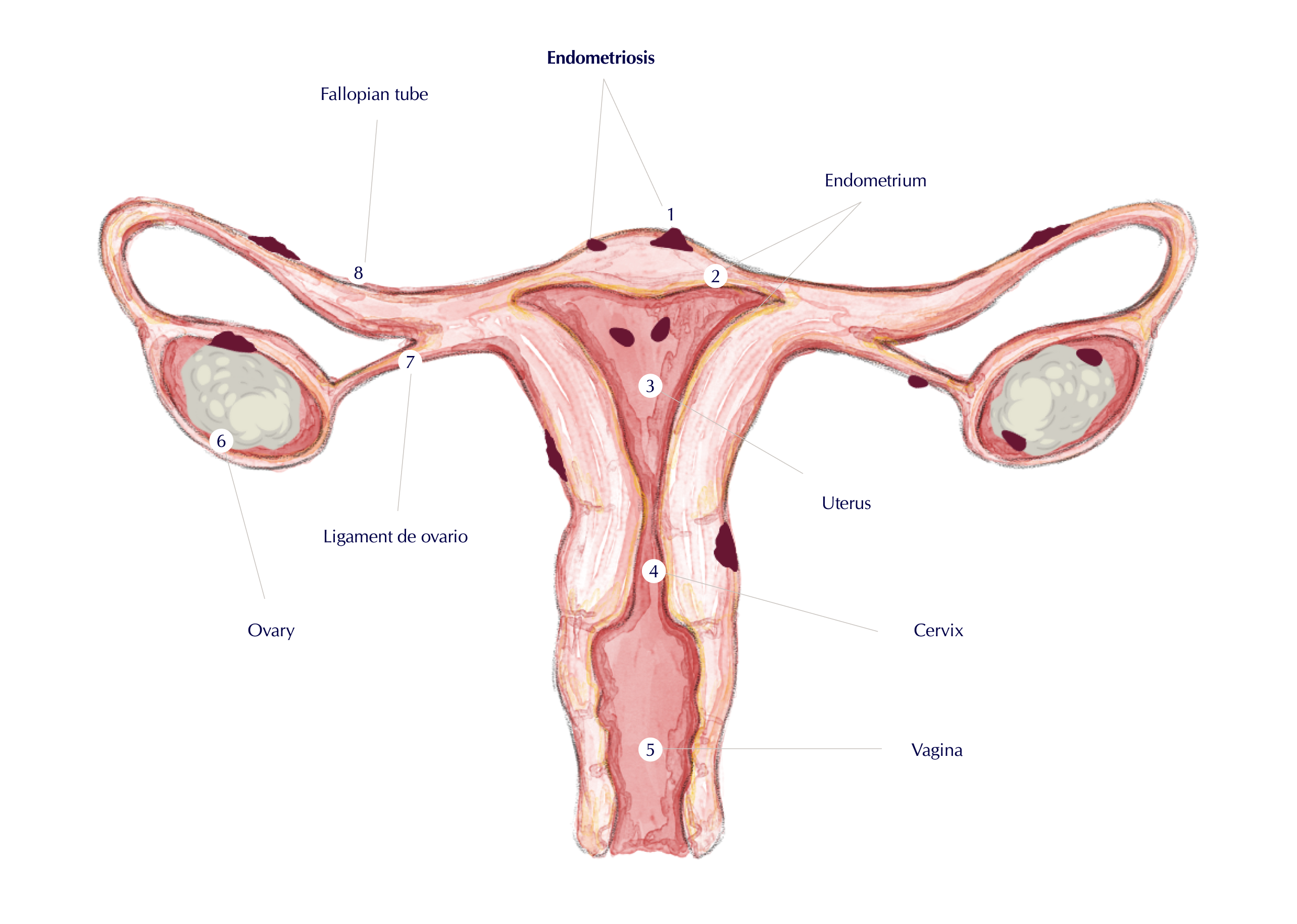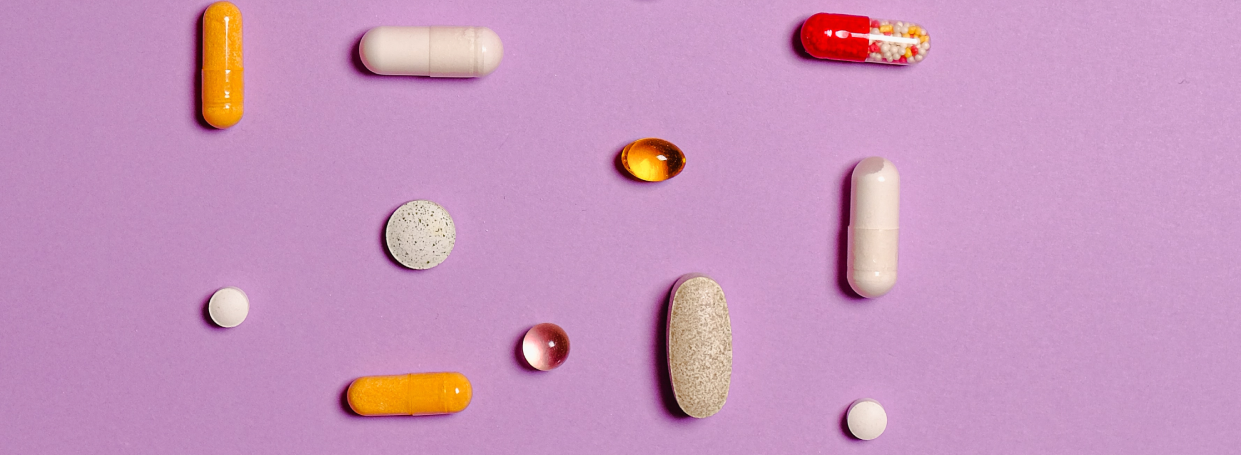

Endometriosis is a condition where tissue like your uterine lining grows outside the womb: on the ovaries, fallopian tubes, pelvic tissues, or more rarely, in other parts of the body. If this tissue grows on the muscular wall of the uterus, it’s called adenomyosis.
This tissue acts like your uterine lining during the menstrual cycle: it thickens, breaks down, and then bleeds. But it doesn’t drain out of your body like period blood and instead gets stuck, which can cause cysts, scarring, and adhesions (bands of scar-like tissue). Around 10% of women of reproductive age around the world have endometriosis.
This article has been verified by a medical professional
Impact of endometriosis on fertility
Up to 50% of women with endometriosis experience difficulty getting pregnant. This condition affects fertility because tissue growth or scarring can damage the ovaries or fallopian tubes, blocking the movement of sperm or eggs. Endometriosis can also harm egg quality and distort pelvic anatomy.

Potential causes of endometriosis
There’s not a clear cause for endometriosis, but experts believe it to be due to one or a combination of the following factors:
- Retrograde menstruation: When period blood with endometrial cells flows back through the fallopian tubes and into the pelvis rather than leaving the body through menstruation.
- Cellular transformation: When hormones or immune factors cause cells outside the uterus to change form.
- Endometrial cell movement: When blood vessels move cells from the uterine lining around the body.
- Immune system disorder: When the body can’t get rid of the endometrial-like tissue growing in other places.
- Surgery: After an operation in the pelvic area (such as a C-section), endometrial-like cells may grow at the location of the incision.
Genetics and environmental toxins could also play a role.
Symptoms of endometriosis
Women experience this condition differently and symptoms can vary from very mild to severe. The most common sign is chronic pelvic pain. Other symptoms include:
- Period pain that gets in the way of daily life
- Pain during or after sex
- Uncomfortable bowel movements and painful urination
- Fatigue
- Heavy periods or bleeding between periods
- Bloating and nausea
Diagnosis of endometriosis
Based on your symptoms, LEVY makes a suspected diagnosis for endometriosis. We recommend you visit an OB-GYN for a physical exam to confirm if you have this condition. Endometriosis can be diagnosed through the following methods:
- Pelvic exam: Your doctor inserts their fingers into your vagina and places the other hand on top of your tummy to check for cysts, scarring, or enlarged ovaries.
- Laparoscopy: A surgeon makes a tiny cut on your belly and inserts a small instrument that lets them see inside your abdomen. Any abnormal tissue found during the exam can also be removed with this method.
- Imaging techniques: Your doctor may do an ultrasound, magnetic resonance imaging (MRI), or a computerized tomography (CT) scan to look at your pelvic area.
When diagnosed, endometriosis gets classified into four stages (I-IV), ranging from minimal to severe.
Treatment to improve fertility
Although there’s, unfortunately, no definitive cure for endometriosis just yet, treatments exist that can ease symptoms and improve fertility. Your age, how long you’ve been trying to conceive, and level of pelvic pain are all important factors to consider when deciding on the right path for treatment.
Surgical operations, including surgical ablation and laparoscopy, can destroy or remove endometrial tissue, scarring, and ovarian cysts to reduce pelvic pain and improve the chances of conceiving. Studies have found that surgery helps almost 40% of infertile women with endometriosis get pregnant within 2 years. Assisted reproduction treatments like intrauterine insemination (IUI) and in vitro fertilization (IVF) may also be recommended to help you conceive.
It’s possible for the endometrial tissue to grow back after surgery and pain to return, so many women need other treatments over the long-term. For instance, birth control pills can lessen period cramping and pain from endometriosis.
Lifestyle changes like adopting an endometriosis-friendly diet, exercising more, and practicing meditation can also help to manage symptoms and improve quality of life. Add more foods rich in antioxidants, fiber, iron, and healthy fats to your plate as they may help reduce inflammation and pain from this condition.
The good news is that lots of women with endometriosis are able to have a baby, either naturally or with medical assistance.
This article has been verified by a medical professional
- Endometriosis. World Health Organization. Accessed 10 February 2022.
- Huijs E & Nap A: The effects of nutrients on symptoms in women with endometriosis: a systematic review. Reproductive Medicine Online. 2020;41(2): 317-328.
- Endometriosis (booklet). ReproductiveFacts.org from the AmericanSociety for Reproductive Medicine. Accessed 10 January 2022.
- 31 Ways to Help Relieve Endometriosis Pain. Healthline. Accessed 10 January 2022.
- Lee HJ et al: Various anatomic locations of surgically proven endometriosis: A single-center experience. Obstet Gynecol Sci. 2015;58(1): 53-58.
- ESHRE Guideline Endometriosis. European Society of Human Reproduction and Embryology. Accessed 10 February 2022.
- Palep-Singh MR & Patil SB: Fertility outcomes in women post surgery for endometriosis. Fert Stert. 2018;110(4): E394.
- Soriano D et al: Fertility outcome of laparoscopic treatment in patients with severe endometriosis and repeated in vitro fertilization failures. Fert Stert. 2016;106(5): 1264-1269.
- Uterine artery embolisation for treating adenomyosis. National Institute for Health and Care Excellence.
- Endometriosis. Mayo Clinic. Accessed 10 February 2022.
- Sanchez, Ana Maria et al. Is the oocyte quality affected by endometriosis? A review of the literature. J Ovarian Res. 2017; 10(43). doi: 10.1186/s13048-017-0341-4
- Laparoscopic Surgery for Endometriosis. University of Michigan Health. Accessed 24 January 2022.
- Missmer SA et al.: A prospective study of dietary fat consumption and endometriosis risk. Human Reproduction. 2010;25(6): 1528-1535.
- Jurkievicz-Przondziono J et al: Influence of diet on the risk of developing endometriosis. Ginekologia Polska. 2017;88(2): 47748.
- Marziali M et al.: Gluten-free diet: a new strategy for management of painful endometriosis related symptoms? Europe PMC. 2012;67(6): 499-504.
You might also like...

Excess vitamin B12 and pregnancy
Excess vitamin B12 during pregnancy can increase the risk of health complications for the baby. Vitamin B12 is an essential vitamin that...

Macrocytic hyperchromic anemia
Macrocytic hyperchromic anemia means that your bone marrow produces unusually large and dark red blood cells. These cells don’t have the nutrients...

Leukopenia
Leukopenia means that you have a low white blood cell count. White blood cells, or leukocytes, are vital to your immune system....

Endometriosis
Endometriosis is a condition where tissue like your uterine lining grows outside the womb: on the ovaries, fallopian tubes, pelvic tissues, or...

Excess folic acid and pregnancy
Folic acid is the synthetic form of folate (vitamin B9). Folate is an essential vitamin that your body needs for cell and...

Microcytic hypochromic anemia
Microcytic hypochromic anemia means that your body has too few red blood cells and these cells are smaller and paler than usual....

Normocytic normochromic anemia
Normocytic normochromic anemia means that you have a low red blood cell count, but your red blood cells have a normal shape,...

Vitamin B12 Deficiency
Vitamin B12 is an essential nutrient that our bodies need to work properly. It helps with nerve function, cell metabolism, and the...




